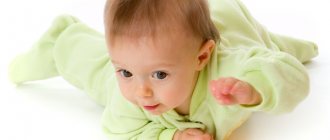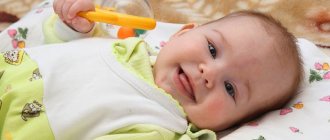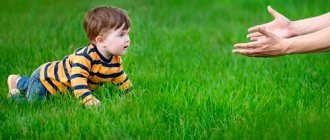The first year of a baby’s life is considered one of the most active periods, when he develops at tremendous speed: he learns to hold his head, walk, roll over, hold objects in his hands, crawl, sit, walk and even talk. Every day the baby becomes more mature and interesting, parents need to devote as much time and attention to their child as possible so as not to miss important moments in his development. One of the first skills that a baby masters is the grasping reflex. The newborn is not yet able to control his movements, but already in the third week he willingly follows bright objects with his eyes. And closer to two months, the baby typically flails his arms and legs; a little later he is able to consciously grasp and hold objects in his hands. You need to know when a child begins to hold a toy and how to help him in this difficult task.
Child development from 1 to 3 months
During this time, the baby grew a little stronger and gained weight. Already at two months, the baby can briefly raise and hold its head, distinguish colors, examine surrounding objects, recognize mom and dad, and also walk.
Many parents are interested in the question of when a child begins to hold a toy. Mastery of this skill usually occurs in the third month of the baby’s birth. At this age, he tries to reach out to the toy of interest and hold a small rattle. In addition, by the end of three months the baby can independently remove the pacifier from the mouth and insert it back.
The role of a rattle in a child's life
External stimulation is a very important element of learning in the life of a baby. It is essential for physical, sensory, emotional and social development. The first toy in a baby’s life is a rattle; it functions as an external sensory stimulus.
The benefits of rattles for a child
It is common to think that baby rattles entertain the baby. In fact, they serve not only for entertainment, but are of great benefit in the development of the baby’s intelligence:
- Stimulates emotions. You can use a rattle to attract your toddler's attention by making sounds, and then play with him. When a child begins to respond to the rattles that his mother plays with him, he tries to smile, an emotional connection is formed between the baby and his parents;
- Stimulates the development of sense organs. The baby hears sounds. The bright, beautiful colors of the toy do not leave him indifferent and contribute to the development of the visual organs, different textures of the surface of the products - the organs of touch;
- Improve coordination. The child wants to take a bright object that he sees, for this he needs to coordinate his eyes and hands. Each time he takes the toy more and more confidently;
- Develop memory. Different rattles are associated with different sounds, the baby remembers and learns to distinguish between them. In addition, you can use different toys before different routine events, for example, some before feeding, others before bathing. In this way, the child can remember what event will follow the game with a specific object. This improves memory and helps the baby feel safer.
Child development from 4 to 6 months
A four-month-old baby is already able to climb up onto his arms, hold and turn his head, and respond to his name. In addition, this is the very period when the child begins to hold toys on his own more confidently, examine them and put them in his mouth. Starting from five months, the baby can independently roll over from tummy to back, laugh, distinguish family from strangers, sit with support, and also suck fingers and toes. At six months, the baby's movements become more confident. In addition to the fact that during this period the child can sit down without assistance, get on all fours, pronounce syllables, he also learns to transfer a toy from one hand to another.
When does a child become interested in toys?
In order for a child to begin to be interested in toys as objects for performing all kinds of manipulations, several important things must happen:
- The level of intellectual development should be such that the baby develops an interest in learning about the things around him. This requires developed vision, hearing, the ability to control the actions of the hands with the help of the eyes, as well as an understanding that the world is not limited to what is directly in front of the eyes, and objects have different purposes that need to be understood experimentally.
- To explore the surrounding reality you need certain physical skills. The child must become more mobile: learn to roll over, lie on his tummy, and sit. This makes it possible to look around and take out objects of interest.
- Handles should be able to take the thing of interest, hold it, shake it, and move it.
Only under these conditions will the child be able to play with rattles, become interested and take them out, and not just hold in his hands what his mother put in them.
Usually all this comes to the child around six months. The baby becomes interested not only in what rattles, but also in what rustles, crunches, makes musical sounds, and lights up when pressed. He learns to perform all kinds of manipulations with an object, and not just take it. Now the baby can give the item back if asked.
Give your baby a piece of polyethylene - it will captivate him for a long time. Just don’t leave your baby alone with the bag – it’s unsafe. A stream of water from the tap will arouse the same interest in him.
Child development from 7 to 9 months
From this age, the baby has a wild desire to learn something new and yet unknown. At this time, the child can sit up independently, crawl, stand up and walk with the support of his parents, hold books and toys in his hands, remember parts of his body and show where his mouth, eyes, nose, etc. are located. By nine months, the baby can already speak a few simple words, move along the wall or crib, dance to the music. And also, in addition to toys, he is able to independently take food and put it in his mouth.
Features of the development of the grasping reflex
When a baby acquires the ability to hold objects in his hands, a fascinating and diverse world of play opens up to him. The first manifestation of the grasping reflex is the beginning of the path to mastering such activities as independent eating, writing, drawing, etc.
The development of the grasping reflex occurs in stages. This reaction is innate, but it takes time to improve (about a year). During this period, the baby’s movements will become more confident, coordinated, and conscious. The intensive development of the reflex begins at the age of 3 months and then only gains momentum.
So, the formation of reactions goes through several stages:
- From birth to 2 months. Babies are born with a set of innate unconditioned reflexes in their “arsenal”. If you press the palm of a newborn with your finger, the baby will immediately close it. Such an action is performed automatically and is not realized by the child. During the first weeks of life, your baby will keep his arms clenched most of the time. However, gradually an interest in the world around him and his own body will awaken in him. As a result, the baby will begin to open and close his palms, thus exploring himself, grabbing nearby objects, exploring space.
- At 3 months. The baby is not yet aware of his capabilities and desires, but at the same time, the development of reflexes from this moment begins to occur more intensely. The little one is already getting used to the toys and perks up joyfully at the sight of them. 3 months is exactly the age when a child begins to reach out to nearby toys. Thanks to this, the eyes actively develop and hand coordination improves.
Recommendation. To stimulate positive reactions, it is worth hanging a mobile with rattles over the baby’s head: the child will lie and look at them, trying to touch them. Another way to stimulate the skill is to play with the baby: you can lightly cover the baby’s face with a diaper and then remove it. Watching how his mother removes the fabric from his face, the baby will try to pull it on his own.
- From 4 to 8 months. By this time, the child becomes more curious and begins to actively explore the world around him.
Important! During this period, to ensure the safety of the baby, it is necessary to remove dangerous objects, as well as toys consisting of small parts, from his free access.
By 8 months, a child, as a rule, already knows how to firmly hold one or another thing in his hands. However, he will still lack dexterity. Between 3 and 12 months, the baby begins to pick up objects and then taste them. To avoid troubles, but at the same time allow the baby to develop skills, you can give the baby a baby spoon to play with.
- From 9 to 12 months. By this time, the grasping skill is well established, the child’s hands become stronger and stronger, and, accordingly, the grip too. Interestingly, until the age of 2 years, the baby does not feel the difference between the right and left hand.
- After a year. Later, a one-year-old child discovers a new interesting activity - throwing toys. During this period, the baby really likes to throw objects and wait for his mother to pick them up and give them to him so that he can throw them again. This behavior is the norm, which is why maximum patience is required from parents. Starting from the age of 2, kids turn into real artists, which is what wallpaper primarily suffers from. At this time, children show great interest in the corresponding attributes: paints, pencils, crayons, etc. At the age of three, coordination of movements reaches a sufficiently high level of development so that the child can put his signature on paper (even if uneven and ugly).
Baby development from 10 months to one year
At this age, the child becomes even more interested in playing with toys and exploring them: he already knows how to roll cars and throw a ball. In addition, the baby is able to play with small objects, for example, sort through cereals. In addition to the fact that by the age of one year the child begins to sit, squat, walk, jump, he also knows how to drink and eat independently, take off his socks and hat, and wave his hand as a sign of greeting or farewell. A one-year-old baby is able to assemble and disassemble construction kit parts, help brush his teeth, comb his hair, and wash his face.
How many months does a child hold a toy?
According to child development standards, a baby is able to hold toys by the age of three months. But due to the grasping reflex, cases occur when a child begins to hold a toy in his hand already from two to three weeks after birth. This action occurs involuntarily in the baby; he is not yet able to control it. To attract the baby's attention, you should use bright toys located at a distance of at least thirty centimeters from his face. For such cases, colored rattles are suitable. But in order not to scare the baby, it is important to choose toys without sharp and loud sounds. In addition, when the child begins to hold the toy, do not offer the baby heavy items, as he may drop them on himself. Thus, closer to three months, the baby can hold compact things in his hands, look at them and put them in his mouth. Let’s look at how many months a child begins to hold toys consciously.
When can a newborn be given rattles?
They can be given precisely from the neonatal period, that is, in the first weeks of life. Of course, the baby is not yet able to examine the object and consciously take it, but he is already reacting to the sounds emanating from the rattle. In addition, a newborn has a developed grasping reflex, so he will grab everything that touches his palms: toys, mother’s finger, hair or nose. But this grasping is reflexive, unconscious. That is why the baby will not be able to give away the object himself: he also does not yet know how to unclench his fists. Mom will have to do this. Having grabbed it, the baby will hold the toy in his hand, if it is light enough, until the mother pulls it out of her fist. But just hold on, nothing more. Manipulation with objects is not yet available to a newborn. The first weeks of his life are spent at the mercy of reflexes. As they fade, the baby will acquire conscious skills.
For the baby to grasp, the most convenient are small bright rattles in the form of an oval or a ring, on which small parts are hung that make sounds when they collide.
At about 3 weeks, the baby begins to follow a toy located a short distance in front of him. If you move an object slowly in front of a child’s eyes, he will have time to catch and follow it with his gaze. That is, the baby begins to respond to rattles not only as a source of sound, but also as a moving object.
Eye contact
To do this, show your child a bright rattle at a distance of thirty centimeters from his eyes. Make sure your child is interested in the toy and is watching it closely. And only after that, slowly move the rattle with shaking, first down and up, and then in the lateral directions. This workout must be repeated at least three times. It is important that the child does not lose the object from his field of vision.
We put the toy in our palm
To arouse a child’s interest in a rattle, it is necessary that it be in his field of vision next to his palm. Then touch the baby’s fingers with the toy so that he pays attention to it. Place the offered item on the baby’s palm; most likely, he will try to grab it. The first attempts may look quite uncertain and incorrect, but each time this action will turn out faster and better. In this exercise, regularity of training is important, which must be done about five times for each handle in turn. Make sure you grip the toy correctly.
Handle control
At the moment when the child is holding the toy in his hand, take the baby by the forearm and move his hand with the rattle in different directions, but within the field of view. The final result of the exercise is that the baby can independently hold the toy during training. An example of playing with a child can be seen in the following video.
If the previous exercise was successful, then you can try to bring the baby’s second hand closer and touch the one in which the rattle is located. This action will contribute to the development of transferring an object from one hand to another.
How to teach a child to pick up a toy
example of the first rattle
In most cases, a baby's first toy will be a rattle. Therefore, to begin with, it is very important to purchase the right rattle in the store. The baby's first rattle should be bright, light, with finely fragmented filling that creates a soft sound to prevent the baby from flinching. The handle of the rattle should be straight, resembling the handle of a spoon. Don't forget to wash it thoroughly with baby soap and warm water before giving it to your baby. My recommendations on how to teach a child to pick up a toy apply to children in the first months of life. And before the baby reaches for the toy, he must learn to look at it or pay attention to it.
mobile for crib
The first desire to look at a toy appears in a child at the age of 1 month, then he begins to trace it with his eyes. For such an activity, a “mobile” toy attached to the crib is well suited for the baby. In the third month of life, the child follows the toy by turning his head in all directions. And only then he tries to reach out to the toy. By the age of 3 months, physiological muscle hypertonicity in the hands decreases, so it becomes easier for the baby to unclench his fist and extend his hand. In some cases, such as prematurity or birth trauma, children master these skills with a delay of more than a month. If you train your child's attention and tell him how to pick up a toy correctly, he will quickly begin to do this on his own, which will contribute to his intellectual development. Before training, I recommend additionally massaging the palms and fingers according to the proposed method (see link), preparing the small muscles of the hand for action, focusing the child’s attention on his hand, encouraging him to look at the fist
So, how to teach a child to pick up a toy:
Start your lessons by practicing tracking a toy. Show a bright rattle to a child lying on his back at a distance of 20-25 cm from his eyes, attract his attention and make sure that the baby is looking at it with interest. Then slowly move the toy with shaking, first in lateral directions, then up and down, and optionally in a circle. But make sure that the baby does not lose the toy from his field of vision. Repeat the exercise, gradually increasing the number of repetitions to 4-5 times in each direction. The final result of the training should be smooth tracking, accompanied by a full turn of the head in all directions. Only after this, training for the participation of the child’s hands is added to the exercise.
Toy tracking
The next stage will be the baby's attempt to touch the toy. For this desire to appear, the toy must come into the child’s field of vision next to his palm. It looks like this: when the child turns his head for the offered toy, touch the rattle to the child’s fingers, drawing his attention to it
The baby’s next desire will be to unclench his fist, and at this time you touch the handle of the rattle to the baby’s palm. He will try to grab the toy offered to him. At first it will not look very correct and confident. Repeat 3-5 times, be sure to do each hand in turn. Each time it will work out better and faster
trying to take a toy
Make sure that the grip of the toy is correct, i.e. the thumb should be opposed to the rest.
If a child takes and holds a rattle, try taking him by the forearm and moving his hand with the rattle in different directions, but within his field of vision. In this case, the child himself must hold the toy.
If the previous exercise worked, then bring the child’s free hand closer to the toy held by the child and let him touch it with his free hand. This will help the child learn to transfer the toy from one hand to the other.
After the baby has learned to reach out to the rattle while lying on his back, offer to reach for a nearby toy from a position lying on his stomach as a more complex option. But first show the necessary movements several times, with the participation of the child’s hand.
Recommendation from a pediatric osteopath . Parents sometimes notice that the child takes toys more often and more willingly in the left hand. Accordingly, they have a question: is the baby left-handed? It is safe to say that in infancy it is still impossible to determine whether a child will be left-handed. His preference in some cases to be more willing to use his left hand depends on the following factors. The most common option is when parents often hand the child a toy to the baby’s left side, while the parent is right-handed and when communicating with the child, the baby’s left hand turns out to be closer and more convenient for the parent. As a result, it turns out that the hand to which the object is held out more often develops faster, and the child begins to use it more willingly. Another option is possible, in which the muscle tone in the hand has been changed since birth, then there is increased muscle tension (hypertonicity) or decreased muscle tension (hypotonia). These deviations were brought to your attention in the testing section. This reason also contributes to the unequal development of movements in the hands. The arm in which the muscle tone is greatly changed will lag behind. But in any case, be sure to keep in mind that you need to develop motor skills and coordination in both hands equally. Otherwise, incorrect placement of the hands, bringing the first finger to the palm, fingers clenched into a fist due to increased tone lead to late and incorrect grasping of objects with the hands, as a result of which the mental development of the child is disrupted, with age, fine motor skills, learning to write and draw. If you have any doubts about the timeliness and correctness of the development of motor skills and coordination in a child, a pediatric osteopath will be able to determine the presence of dysfunction and carry out the necessary manual correction.
- Ask questions on the topic on the forum.
- Subscribe to my page on Instagram.
- Use my osteopath online channel on Telegram.
- Make an appointment for an in-person appointment in Moscow.
*Articles on massage, exercise therapy and doctor’s recommendations are for informational purposes only and do not constitute advertising of services.
Changing position
After the child has mastered the skill of reaching out to the toy while lying on his back, offer him to reach the rattle from a position lying on his tummy. This option is the most difficult, so you must first demonstrate these actions several times with the participation of the child. Don't forget to praise your child for completing a task correctly. This will allow him to realize success, which will become an incentive for subsequent exercises in the future.
What toys to choose for a child
We found out what time a child begins to hold a toy. But for safety and skill development, you need to choose the right rattle. The baby's first toy should be light and bright with finely fragmented filling, and not make a sharp sound so as not to frighten the child. It is best to choose a toy with a straight and long handle. Before showing your new rattle to your baby, be sure to wash it in warm water and baby soap. The assortment of rattles in children's stores is varied, so in order not to get confused, you should give preference to bright colors as your child's first toy: red, yellow, orange or green. Items should be of different shapes and textures, which will help develop fine motor skills and tactile sensations, as well as shape taste and preferences in the future.
In the first six months, three toys that can be hung in a stroller or crib will be enough for the baby. For a six-month-old child, you can purchase educational and moving toys of different textures. It is important that they do not make loud sounds and are not heavy for the baby. In addition, the child should be comfortable holding them in his hand.
When does a child begin to control his hands?
It is not so easy for a baby to control his own hands. To begin with, he will learn to grab one of his hands with the other, clench and unclench his fists. This happens around the beginning of the second month. But at this time the child has not yet realized that he has such wonderful devices as hands and fingers. Now the hypertonicity of newborns has not yet subsided (although, perhaps, it has already become less noticeable), which is why it is impossible for him to independently raise his hands to his eyes and look. But it will happen very soon - around the end of 2 months.
If musical mobiles are hung in the baby's crib, it is from this moment that he begins to reach for the toys on him and push them. At first, this will most likely happen by accident. The baby will hook a small object with its handle and it will make a sound. The baby tries to repeat the procedure, reaches for the toy, pushes it to hear the sound again.
At this age, it is especially important to give the baby toys in his hands.
Gradually, as reflexes fade and hypertonicity decreases, the child will more and more actively study his hands, learn to understand that with their help you can not only push or touch objects, but also grab them, hold them, shake them, etc. The process of developing small skills begins motor skills and coordination of movements using new tactile sensations.
By about 3 months, the baby will begin to study hands for a long time: examining, touching fingers, sucking them, exploring not only with his eyes, but also with his mouth. He also quite consciously pulls objects that fall into his hands into his mouth to explore.
By 4 months, the child begins to consciously hold the rattle placed in his hand. If he is already teething at this time, he is quite capable of understanding how to use a cooling teether.
Do not wean your baby from sucking on anything and everything: this is not a bad habit, but an important life stage, an experience in learning about the world around him in ways accessible to him. It is better to ensure the cleanliness of those subjects that he constantly studies.
On a note
During the exercises, it is important to be in a good mood not only for the child, but also for the parent; you need to talk with the baby and conduct classes in a playful way. Do not forget that mastering a new skill requires time, diligence from the baby and repeated repetitions. Almost every child has difficulty holding an object during his first attempts. But under no circumstances should you compare your baby with other children or get angry with him. Encouragement and systematic activities with the baby will help to significantly speed up the acquisition of a new skill and will have a positive impact on its overall development. To summarize the above, we note that when working with a child, the following recommendations should be taken into account:
- As a first toy, it is better to choose a rattle with a long handle, about fifteen centimeters. The color should be bright and the product itself should be light.
- By six months, a child may have toys in his arsenal that vary in shape, color, and material. Musical rattles with unusual fillings and textures are also welcome, as new tactile sensations contribute to the development of fine motor skills and gradually form preferences.
- For the safety of the baby, it is under no circumstances recommended to leave him alone with the toy.
- Make sure that your baby is fed, calm and healthy before exercise, as he should not be distracted by anything during exercise.
- Each exercise must be performed in turn for each hand, so as not to develop the skills of only left-handed or right-handed people.
- Psychologists advise praising the child after each successful exercise. This will become an incentive for the baby to make further efforts.
- Great attention should be paid to the cleanliness of toys. All children tend to explore the world in various ways, including tasting something interesting. Typically, babies put all objects in their mouths when they are teething. Scolding for such pranks is sometimes useless, so it is the responsibility of parents to ensure the safety of their children.
- Regularity is important in acquiring new skills, otherwise the child may lose interest in classes.
- It is recommended to carry out the proposed exercises in the form of a game, using nursery rhymes, songs or rhymes.
Speaking about how many months a child begins to hold a toy, do not forget that all babies are individual, and the development of each of them occurs differently. Some babies look at objects with interest already in the first month of life. Undoubtedly, what is important is how long the child holds the toy, but if a baby at four months old does not hold objects well, there is no need to panic. He may need a little more time to master this skill. If relatives have suspicions about the baby’s development, it is worth contacting the child’s attending physician. If after checking it turns out that everything is fine with his vision, reactions and nervous system, then you should just wait, he will gradually master this skill. Sometimes kids refuse to pick up toys they don’t like. Therefore, in such cases, you need to offer the child rattles of various shapes and colors. The age at which a child begins to hold a toy depends on the time parents devote to teaching.
The role of toys in personality development
The toy accompanies the child almost from birth, having a significant impact on the physical and mental development of the baby, namely, it contributes to the formation and improvement of:
- Memory;
- Attention;
- Imaginations;
- Motor skills;
- Dexterity;
- Coordination;
- Vision;
- Perception of sounds;
- Social skills.
A child tries to sit up at 4 months - is it possible?
Thanks to these items, the baby gets acquainted with such concepts as color, quantity, shape, size. In the process of regular play activities, the child’s brain accumulates mental changes, which subsequently have a significant impact on the formation of personality.
On a note. A toy is a child’s first teacher, created by adults to prepare him for entering into social relationships and gradually entering the adult world.
Rattles are the very first toys for a baby. With their help, parents establish an emotional connection with the baby and communicate (accompanying the game with affectionate words, smiling, singing). The bright appearance of the rattle and the sound it makes attract and hold the child's attention. Subsequently, the object becomes interesting to the baby from the point of view of manipulation: by six months the baby begins to actively grab it, due to which reaction, coordination, and visual attention develop. The baby begins to wave the rattle, throw it, pick it up, shake it. Gradually, the child develops an understanding of cause-and-effect relationships: a one-year-old baby realizes that the actions he performs with a rattle entail certain consequences (for example, if the object is shaken, it will make a sound).
Thanks to contact with musical toys (drums, bells, rattles, children's gourds), the child develops musical taste and a sense of rhythm.
By playing with didactic toys (collapsible structures), a one-year-old baby improves motor skills, learns to show independence, begins to realize the results of his own efforts, and masters sensory standards. In addition, the bright appearance of objects, the variety of shades and shapes, and their harmonious combinations develop a child’s aesthetic taste.
In preschool age, a variety of games are used, for example, construction, director, role-playing and others. Such activities develop the child’s imagination, form social skills, and introduce him to certain professions.
On a note. It is important to choose the right toys for your child. This is done taking into account the age, characteristics of physical and mental development, the need for any activity, and the interests of the baby.
Mobile with rattles











